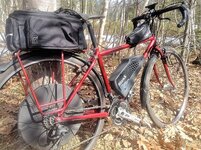Mike TowpathTraveler
Well-Known Member
Bike: 2016 model year Haibike Full FatSix. Commissioned in April, 2017. Yamaha PW drive. FSA front double chain ring. Shimano HG chain. 10 speed Shimano Rear Cassette.
Current miles on odometer: Approx 12,200. At around 11,000 miles, I finally stretched the chain beyond it's usable limits to the point where in starting to pedal, the chain would skip right off the front chain ring from the excessive slack.
I pedal in mainly water level riding, just local steep gradients coming out of a creek shed.
I religously keep the chain clean and lubricated with DuPont Chain Saver Spray Lube. How religious? Every other ride.
I pedal "lightly", shifting all the time to stay in or around 78 rpm. I do not "mash the pedals", instead.....I shift gears. Lots and lots of times on each ride. Prior to each shift, I ease up pressure on the pedals to avoid shock loading the chain, motor, chain ring, cassette. The Yamaha does NOT have shift detection like the Bosch does. YOU are the shift detection. OR....maybe you are not the shift detection!
TLDR.....but I wanted to set that all up to say that no matter how religous you are in lubing the chain, lightly spinning the pedals and the rest that sooner or later, wear is wear is wear. And so it was when my chain finally became unrideable. I figured if I'm gonna replace the chain, well, the front chain ring was shot too and since I was doing the front chain ring, chain too, that I'd treat the Full FatSix to a new rear cassette and rear derailleur too......
The below is what a new front chain ring looks like as compared to a worn chain ring at 11 thousand miles......

I hope this info is of help to you and other people as well. With all of this accumulated wear, mid-drives are still the best way to go, imo.
Current miles on odometer: Approx 12,200. At around 11,000 miles, I finally stretched the chain beyond it's usable limits to the point where in starting to pedal, the chain would skip right off the front chain ring from the excessive slack.
I pedal in mainly water level riding, just local steep gradients coming out of a creek shed.
I religously keep the chain clean and lubricated with DuPont Chain Saver Spray Lube. How religious? Every other ride.
I pedal "lightly", shifting all the time to stay in or around 78 rpm. I do not "mash the pedals", instead.....I shift gears. Lots and lots of times on each ride. Prior to each shift, I ease up pressure on the pedals to avoid shock loading the chain, motor, chain ring, cassette. The Yamaha does NOT have shift detection like the Bosch does. YOU are the shift detection. OR....maybe you are not the shift detection!
TLDR.....but I wanted to set that all up to say that no matter how religous you are in lubing the chain, lightly spinning the pedals and the rest that sooner or later, wear is wear is wear. And so it was when my chain finally became unrideable. I figured if I'm gonna replace the chain, well, the front chain ring was shot too and since I was doing the front chain ring, chain too, that I'd treat the Full FatSix to a new rear cassette and rear derailleur too......
The below is what a new front chain ring looks like as compared to a worn chain ring at 11 thousand miles......
I hope this info is of help to you and other people as well. With all of this accumulated wear, mid-drives are still the best way to go, imo.

